Roses and thornbushes
Texas blooms in brilliant colors, from the brightest blue bonnet to the deepest red rose, and a hundred shades in between.
The 700-mile-wide state is home to a diverse group of ecosystems, from the deserts of west Texas to the wetlands of the Gulf Coast, and the verdant hill country in between. Each of these environments has its own distinct set of flora and fauna for visitors to enjoy.
In the spring, you may see wildflowers as you drive along Texas highways. But no matter what time of year you visit, the state’s gardens and nurseries provide ample opportunities for visitors to enjoy flowers and plants from around the state and around the world.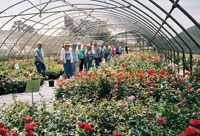
South Texas Botanical Gardens
Corpus Christi
On Texas’ Gulf Coast, the South Texas Botanical Gardens showcase the natural beauty of Corpus Christi and the surrounding area.
“Our garden is 108 acres of natural wetlands and native brush land,” said Michael Womack, executive director at the gardens. “We’re on a wildlife corridor, so periodically we see wildlife like deer, coyote and bobcats. And our large wetland brings in a lot of the shore birds that you would typically see on the beaches.”
The wildlife is attracted in large part by the native plants protected at the gardens. Varieties like thornscrub, ebony and soapbrush are a common sight for east Texas residents, but are critical for keeping native animals in the area.
The gardens also feature a number of more exotic displays, such as the collection of 2,000 orchids, which blooms in the spring and fall.
“We have a plumeria collection, which has almost 100 specimens of the Hawaiian lei flower,” Womack said. “We also have a vermillion conservatory, with about 800 bromeliads. Many of them were hand-collected by a local collector, who traveled through Central and South America to find them.”
This summer, the garden is opening a new butterfly house, where visitors can see the native and migratory butterflies that can be found throughout the year in south Texas.
Lady Bird Johnson Wildflower Center
Austin
The Texas hill country’s wildflowers and other native plants are on display at Austin’s Lady Bird Johnson Wildflower Center, an institution established by the former first lady.
“Since we’re in the hill country, we focus on hill country species, like trees, shrubs, wildflowers and grasses,” said Andrea DeLong-Amaya, the center’s horticulture director. “We have blue bonnets, pink evening primrose, squarebud primrose, cherry sage and other flowers.”
The center has a number of different exhibit areas, ranging from stylized natural meadows to a formally designed area. One exhibit, called the Homeowner Inspiration Garden, features a number of different gardening concepts that people can do in their own gardens with native plants.
There are more native plants in the woodland garden, which has a water feature flowing through it, and in the demonstration gardens, which feature 23 different garden beds planted in large boxes.
“Each of those boxes has a different story to tell,” DeLong-Amaya said. “Some of them cover things like plants that attract hummingbirds. We have a south Texas sampler and a West Texas desert bed, which shows some of the cacti and drought-resistant plants in that part of the state.”
Rose festival and more
Tyler
The northeast Texas city of Tyler is all about roses — the town is nicknamed the Rose Capital of America and produces more than 20 percent of the country’s commercially grown rosebushes.
The city celebrates its rosy reputation each October with the Texas Rose Festival, an event that draws nearly 100,000 visitors to the area each year. The festival features traditional balls and parades, as well as the crowning of a rose queen from among local young women who embody the spirit of volunteerism.
Even if they can’t make it for the fall festival, groups can find plenty of rose-related activities in Tyler.
“We’re a big agricultural area,” said Justin Turner, vice president of tourism at the Tyler Convention and Visitors Bureau. “Most of our tours are based on agritourism of some sort.”
At the Tyler Rose Museum and Garden, visitors can explore galleries detailing the history of rose cultivation in the area and see highlights from past rose festivals. Outdoors, 14 acres of gardens have more than 40,000 rosebushes, with approximately 500 different varieties of roses.
Visitors can also see rose cultivation for themselves at places like Chamblee’s Rose Nursery, where gardeners produce more than 300,000 varieties of roses each year. Guides show groups the variety of antique roses grown in the area, including some with unusual colors, stripes or freckles.
From polkas to pesos
Texas has heard its share of languages over the centuries, from the dialects of early Indian settlers to the Castellan of Spanish explorers and German and Czech spoken by later immigrants to the new West.
Though English is the predominate language in Texas today, visitors touring the state can still find pockets of ethnic heritage in big cities and small towns. Historic sites, restaurants and churches in places like San Antonio, Fredericksburg and LaGrange offer a look into the various ethnic groups that helped to make Texas what it is today.
Fredericksburg
In the mid-1800s, a number of immigration companies bought land in Texas, planning to move tens of thousands of German immigrants into the area. Although the plans never totally materialized, a group of about 140 German settlers came to the area in 1846 and established Fredericksburg, a town that still has strong German roots.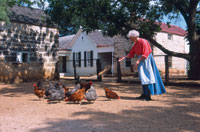
“In Fredericksburg today, you see a lot of German architecture,” said Ernie Loeffler, director of the Fredericksburg Convention and Visitors Bureau. “It’s not like a typical Bavarian village, but it’s the architecture that Germans adapted when they came to the Texas hill country. They did a lot of Fachwerk construction, a German style with a lot of cross timbers.”
A number of restaurants throughout the city serve only German food, and the Fredericksburg Brewing Company produces beer according to strict German brewing laws.
Groups can learn about early German life in the area at the Pioneer Museum, a three-acre area with a number of historic buildings from the German era. Among highlights is the Sunday House, a type of building unique to the Fredericksburg area.
“Some people built their main homes on their ranch and then built small little houses on their lots in town to stay in Saturday night and then go to church on Sunday,” Loeffler said. “The Sunday houses were very small, one-room houses, and sometimes they had a sleeping loft upstairs.”
www.fredericksburg-texas.com
LaGrange
In the early 1800s, the town of LaGrange was settled by a group of German and Czech settlers, and there is still a heavy Czech influence in the area. Visitors can find Czech-influenced food in numerous bakeries around town or visit the Texas Czech Heritage and Cultural Center to learn more about Czech history in the area.
Located on the local fairgrounds, the Heritage Center features a number of historic Czech and Moravian houses from around the region. Structures include a family home, an amphitheater, a farmhouse and a bell and belfry.
Also on the site is the restored Hoescher Haus, which is home to the Polka Lovers Club of Texas Museum. Interested groups can arrange to have polka lessons and demonstrations during their visit.
San Antonio
San Antonio has been called the “northernmost city in Mexico” thanks to a large Hispanic population and a vibrant Latino culture.
“San Antonio began about 300 years ago with Spain staking claim in the area,” said Dorah Putney, director of tourism at the San Antonio Convention and Visitors Bureau. “It was originally an Indian village, and the Spaniards came here to convert the Indians.” 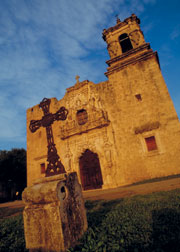
In their efforts to convert the Indians, the Spanish built four missions in the area. The most famous is the Alamo, which was already 120 years old when the Battle of the Alamo took place there in 1836. Visitors can tour the Alamo in downtown to learn about the battle or tour the other missions, which are now preserved by the National Park Service.
Though Texas left Mexico and joined the United States soon after the battle, many people in San Antonio are of Mexican descent, and their culture can be seen throughout downtown. Mexican restaurants along the San Antonio River Walk are one of the hallmarks of the city.
Visitors can find examples of Hispanic culture at the San Antonio Museum of Latin American Art and in historic Market Square, where traditional handmade goods and other items are sold in a Mexican-style market.
Fiesta San Antonio, a citywide event each April, celebrates the city’s heritage with parades, concerts, food and more.
Two stepping through Texas
Nothing could be more typically Texan than the image of the cowboy, rugged, dust-covered and topped with a 10-gallon hat. Although urban areas have cropped up all over the state, the ranching lifestyle is still an important part of modern Texas.
Today, visitors to the Lone Star State have plenty of opportunities to enjoy cowboy heritage. Museums and living-history centers offer a look into the lives of cowboys past, while some of today’s best wranglers compete in rodeos across the state. And adventurous travelers can try their hands at riding, roping and other activities on a number of Texas dude ranches.
National Ranching Heritage Center
Lubbock
Ranch life has always been at the heart of Texas and is the focus of the National Ranching Heritage Center. This museum and historical park deals with the evolution of the Texas cowboy lifestyle.
“We’re a cowboy museum, but also a little more than that,” said executive director Jim Pfluger. “We have 47 actual ranch structures that have come off of ranches in the Southwest, primarily in Texas. Those buildings are from the 1780s on up, so it spans three different centuries of use.”
The building collection includes a wide variety of structures, such as a pair of dugouts, a ranch headquarters, a pitchfork cookhouse and a number of ranch homes. One building is a reproduction of a historic ranch house that still stands between Laredo and the Rio Grande River.
“It was built as a stone fortress to defend against cattle rustlers and Indian marauders,” Pfluger said. “We didn’t bring the original building here, because several of the original ranch owners are buried under the dirt floor of the building. So we built an exact replica instead.”
Some of the homes on the site tell the stories of some minority cowboys, such as John Wallace, an African American who owned a ranch about 100 miles from Lubbock. Taken together, the collection gives a good overview of some of the developments in ranching through time and the Texas landscape.
“As visitors walk through the park, they’re going to see a different type of geography and topography,” Pfluge said. “It’s kind of like the progression moving east to west.”
www.depts.ttu.edu/ranchhc/
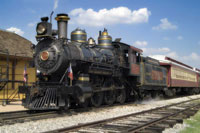
ALL ABOARD!
Cowboys may be the face of Texas, but it was the railroad that opened much of this state and the rest of the West to quick expansion and development. Visitors to Grapevine, a small town between Dallas and Fort Worth, can experience a ride aboard a historic train on the Grapevine Vintage Railroad. Commercial trains stopped going to Grapevine late last century; in 1999, locals opened the Grapevine Vintage Railroad as a tourist train to teach visitors about the area’s heritage. Today, the company takes 85,000 passengers a year along the 27-mile round trip to the Fort Worth Stockyards. Passengers ride in historic cars pulled by a vintage locomotive. The most famous is a steam engine nicknamed Puffy, which is more than 100 years old. Engineers spent more than $1 million restoring the 1896 locomotive, which guests can tour as part of their visit to the rail yard. |
Texas Ranch Life
Bellville
Guests can experience a bit of the cowboy lifestyle themselves at Texas Ranch Life, a working dude ranch and bed-and-breakfast near Bellville and Brenham, which are both a short drive from Houston.
Texas Ranch Life is spread out over three contiguous ranches that comprise more than 3000 acres. Workers raise beef cattle on the ranch and can give groups demonstrations of herding and cutting techniques in the ranch’s covered arena.
Adventurous visitors can go out on horseback with the cowboys, exploring the ranch and looking out for wildlife along the way. Deer, wild turkey, mountain lions, fox and quail all live in the area, and bald eagles are a common site as well.
Groups can arrange for a number of other activities at the ranch. Chuck wagon cookouts are popular, and the staff can set up mechanical bull riding, tomahawk and knife throwing competitions and even skeet shooting.
Interested groups can also overnight at Texas Ranch Life, staying in seven historic ranch buildings from around Texas that have been brought to the site and renovated into home-style bed-and-breakfast units. The ranch homes can accommodate groups of up to 45 people.
www.texasranchlife.com
(866) 839-2775
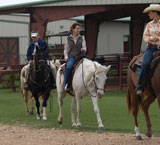
A roundup and a rodeo
Amarillo
Visitors can meet and watch hundreds of modern cowboys demonstrate their skills at a pair of major events that take place in Amarillo each year.
In June, Cowboy Roundup USA brings cowboys from around the country to compete in a chuck wagon cook-off. As many as 40 teams come dressed in 1890s-style clothing and prepare traditional ranch hand fare for both visitors and judges.
“The meals are all prepared by hand at the chuck wagon,” said Eric Miller, director of communications for the Amarillo Convention and Visitors Council. “It’s usually a cowboy fried steak, ranch beans, a potato dish and sourdough biscuits, and they always finish up with a cobbler. It’s all cooked in cast-iron skillets or dutch ovens over an open fire, so it replicates what a cowboy would have eaten.”
The second week of every November, Amarillo hosts the World Championship Ranch Rodeo. Unlike touring rodeos, the competitors in this event are all actual wor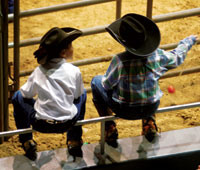 king ranch hands, who compete in ranch-style rodeo events in their off time.
king ranch hands, who compete in ranch-style rodeo events in their off time.
“In ranch rodeo, they do things like team penning,” Miller said. “That means three cowboys, and their challenge is to take a small herd of cattle and move them from one end of the arena to the other and then into a small pen. That’s what they do when they’re working on a ranch.”
The four-day event also includes cowboy music and storytelling, as well as a marketplace where visitors can buy boots, hats, lariats, turquoise jewelry and cowboy art.
www.visitamarillotx.com









